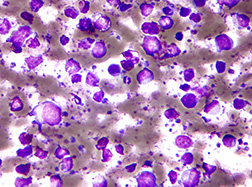Innovations at a Glance
-
Incorporating fusion technology combining multi-parametric MRI with real-time ultrasound to provide a 3D visualization of the prostate to track and target suspicious areas during biopsy

-
Demonstrated that pembrolizumab shows promise for treating advanced, metastatic esophageal cancer in patients whose disease progressed after receiving two types of combination chemotherapy
-
First to describe a genomic pre-malignant phase of acute myeloid leukemia

-
Advancing treatment of metastatic lung cancer through radiation therapy in combination with ipilimumab, an immune system–boosting therapy leading to regression of tumor
-
Developing the role of liquid biopsy to continuously monitor genetic changes in cancer cells in real-time to optimize treatment as the cancer evolves
-
Revealed evidence that a ketogenic diet may improve the effectiveness of an emerging class of cancer drugs that target the insulin-activated enzyme phosphatidylinositol-3 kinase (PI3K)

-
Employing umbilical cord blood cells and salvage chemotherapy to induce remission for refractory acute myeloid leukemia and myelodysplastic syndrome
-
Applying computational and functional techniques that employ physiologic imaging and advanced image processing to correlate imaging characteristics with molecular features of cancer

-
Initiating a clinical trial based on experimental studies targeting the JAK1 and the IL-6 signaling pathways as potentially druggable targets to suppress or prevent graft-versus-host disease
-
Identified the importance of two gene-regulation proteins — LSD1 and TET2 — in the development of lymphomas

-
Conducted the first-ever dose escalation study using convection-enhanced delivery for diffuse intrinsic pontine glioma to bypass the blood-brain barrier and administer a drug directly to a brain stem tumor site



